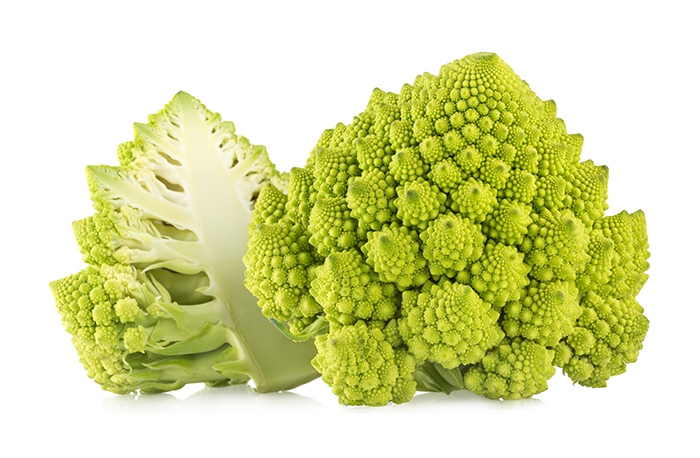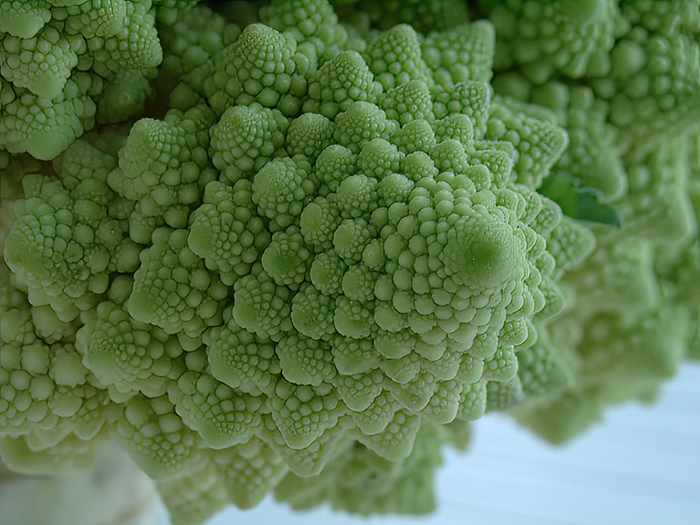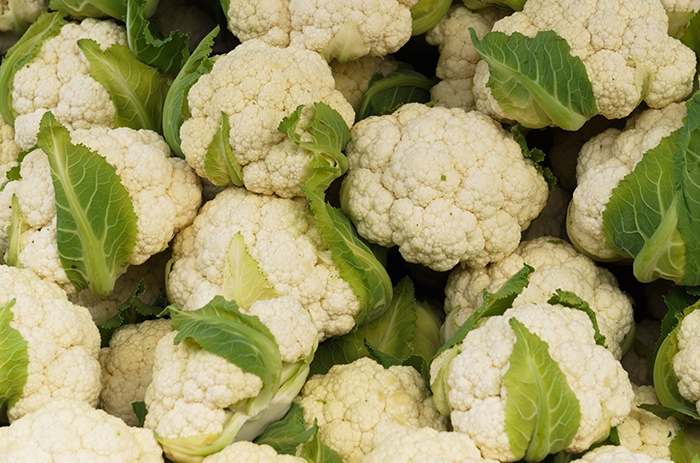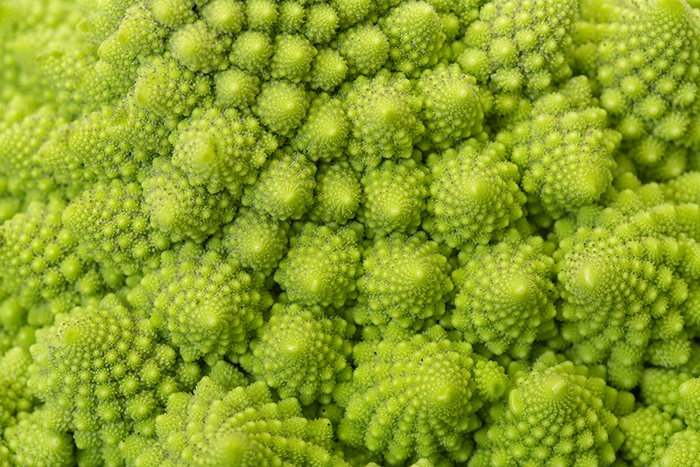
Cauliflower’s Fractal Pattern, A Key To Understanding Nature
In many plants, a self-similar pattern is often observed in leaves, flowers, or shoots (e.g., Fern leaves). Common cauliflowers are exceptional in this regard in that their self-similarity manifests in their florets which are composed of miniature versions of themselves. It is especially evident in the conical-shaped florets of the Romanesco broccoli. This characteristic is an example of the fractal described in abstract geometry. Though people have long studied this repeating pattern in plants for centuries, recently a team of scientists led by François Parcy (CNRS) and Christophe Godin (Inria) identified and explained the mechanism that leads to this unique structure. Through a combination of mathematical modeling and genetic analysis, they were able to reproduce cauliflower and Romanesco broccoli growth on the computer. Their work was published in Science in 2021.
We are honored to be able to interview one of these scientists, Dr. Etienne Farcot of the University of Nottingham in the UK. In the following interview, Dr. Farcot explains their research methods and intriguing findings.

Q: Please tell us about your educational background. How did you get interested in researching the fractal patterns of cauliflower?
A: I studied applied mathematics and computer science as an undergraduate, and then decided to do a Ph.D. in applied maths. This is when I discovered the field of mathematical biology. A few years later, I was hired as a researcher in a team doing research on the mathematical modeling of plants, led by Christophe Godin. The specific research on cauliflower had started shortly before I arrived and was led jointly by a biologist, François Parcy and Christophe, who invited me to join the effort.
Q: Please share with us your research approach and the findings from this research.
A: It was known that formations similar to the common cauliflower occur in Arabidopsis thaliana (a small flower widely used for research in plant biology), as the result of a mutation. This mutation consists of the removal of a gene (in fact two very similar genes) which is used by plants at one of the early stages during the formation of flowers. With this gene missing, the plant initiates the production of a flower, but at the time when the missing gene would be needed only a “blob” has been created and the process stops. The state of some cells within the blob then reverts to that of a stem and they initiate again the formation of flowers, which once again fails. These repeated attempts result in accumulations of blobs characteristics of cauliflowers.
We knew that early on, but what we wanted was to understand better how the same process could generate objects seemingly as different as a common cauliflower and a Romanesco cauliflower. A key element of our approach was to describe the system as we understood it in mathematical terms, and simulate its behavior using a computer. The model included a description of the geometric rules underpinning the formation of new plant organs, as well as the interactions between a few key genes known to play a role. This was needed because the repetition within the process quickly leads to a very large number of “blobs”, whose organization cannot be predicted by mere intuition or using a pen and paper.

Q: Why is cauliflower’s self-similarity unique? How does a cauliflower, especially Romanesco broccoli, follow the Fibonacci sequence and fractal pattern so remarkably well?
A: The occurrence of the Fibonacci sequence is in fact not specific to the cauliflower or Romanesco broccoli. It occurs in many plants and is due to the fact that plant organs are arranged along a spiral: each organ appears at a fixed angle from the previous organ. If you look carefully at a random flower (e.g. a simple weed) you will most likely be able to see how, going from the bottom of the stem to the top, organs follow a spiral arrangement. A fact, whose explanation is still not entirely clear, is that in many cases the angle occurring in these spirals has a particular value known as the “golden mean angle”. Given that value, some (not entirely easy) algebra and geometry can be used to show that the spirals which are most obviously visible will occur in numbers which are part of the Fibonacci sequence. This is for instance particularly noticeable in sunflower heads or some cacti.
So, what is specific about cauliflowers is not the spiral or the Fibonacci numbers, but the fact that they repeat themselves on top of each other, in a self-similar way.
Q: What is the relation, if any, between self-similarity and recursion? Is there an information theory reason for this?
A: Recursion is more general and abstract than self-similarity. It is the act of defining things in terms of themselves. This implies that recursion generates collections of things, rather than single items. An archetype example is integers: define the first integer to be 0 (or 1 depending on taste), and say that given any integer n, n+1 is also an integer.
When talking about self-similarity, there is a need for some form of recursion, but the term refers to a specific property of objects which have been generated using a recursive rule: an object is self-similar if a part of that object is similar to the whole. For instance, drawing dots on a line to represent integers, if we ignore the first few dots what remains is similar to the full set of integers, see the picture below:

Q: From a layman’s point of view, it seems as if self-similarity is an efficient way to create complex structures from simple parts. In other words, simplifying the amount of genetic information needed to be encoded in the genes or making the genetic information more robust from damage (redundancy). What are your thoughts on this?
A: It is true that self-similarity can result from very simple rules. What needs to happen is for the rule to be applied repeatedly (in theory, infinitely many times, but in nature, the repetition has to stop at some point). I am not sure there is always a reason or a need to create complex structures, but they do occur in a lot of situations, notably during growth processes in biology.
Q: Fractals appear all throughout the natural world and at various extremes of scale. Why do you think that is?
A: As discussed in the previous question, fractals (which are self-similar objects) can occur in nature as a result of the repeated occurrence of a “simple” process; for instance: growing a branch or organ, but there are many other examples. I think this has been best discussed by Benoit Mandelbrot and his work is worth reading by anyone interested in the occurrence of fractals in nature.

Q: In general, what applications does this work on the self-similarity of cauliflower have?
A: There is no obvious immediate application; the purpose was firstly to improve our knowledge. However, in general, the link from the activity of genes to the final form of plants is far from being elucidated. Designing new plants (in particular to produce food), by genetic modifications is a very important goal in a world where the population is growing and current plant species are subject to increased environmental stresses. In that sense, showing that the use of mathematical descriptions and computer simulations can lead to reliable predictions on the changes incurred by events occurring within single cells is relevant.
*****
Through the research by the team including Dr. Etienne Farcot, people are able to understand the fundamentals behind the growth of some plants. Implicitly, their findings may benefit humanity in solving the food supply problem in the future.
